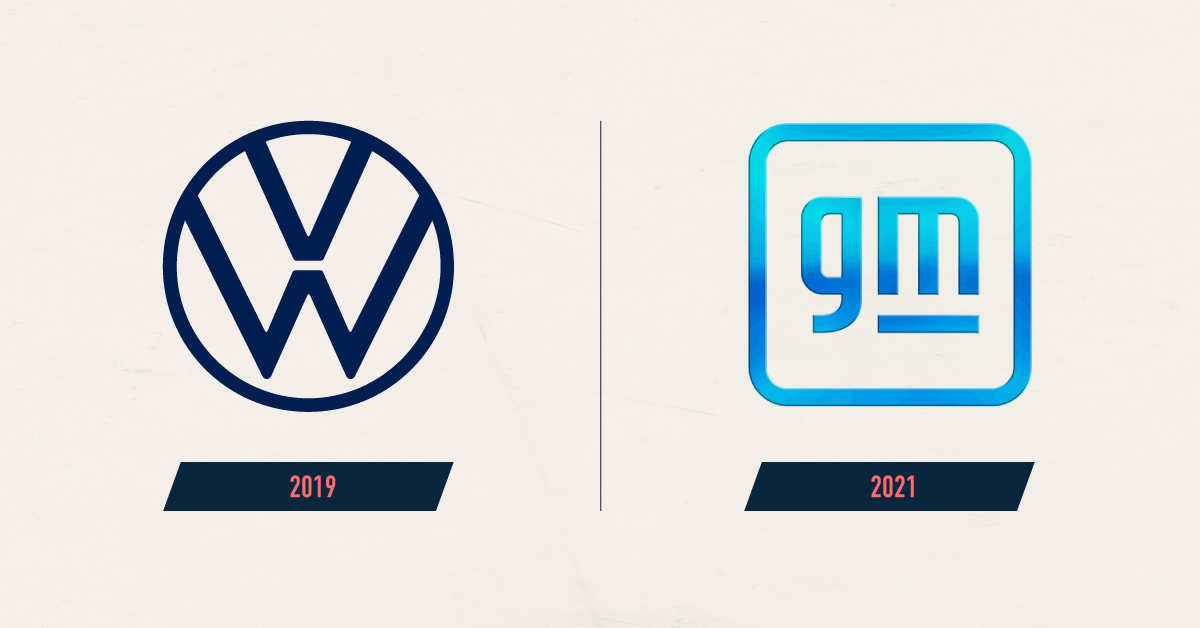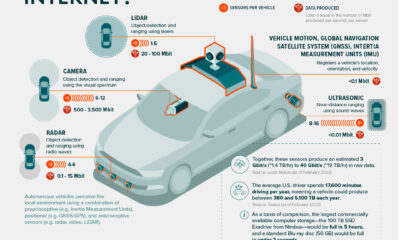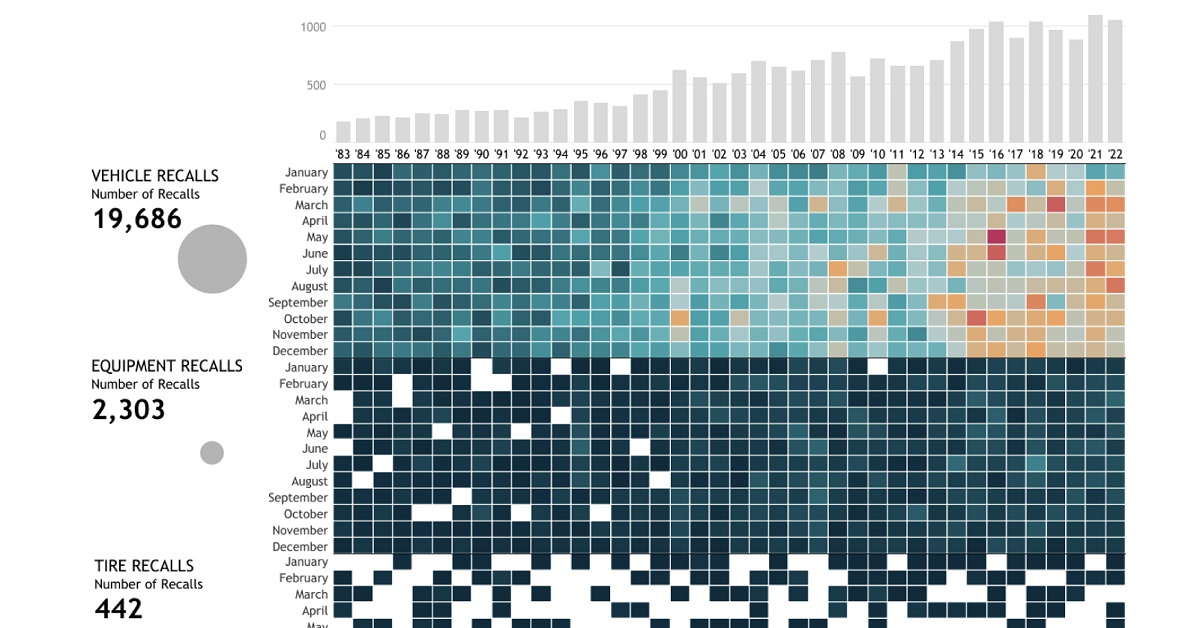For starters, automakers are some of the world’s biggest advertisers. In 2020, the automotive industry spent $33 billion on advertising in the U.S. alone. Automakers also maintain a strong physical presence by placing their logo on every car they produce. This form of self-promotion is an automotive tradition, and because of it, car logos are designed to be eye-catching and memorable. To learn more, we’ve illustrated the histories of six brands of interest. Editor’s note: There are obviously many automotive brands with strong histories, but for this visualization we selected brands that we thought had the most interesting stories and graphical decisions behind their emblems. In the future, we may add more or create a follow-up post if readers express interest.
A Closer Look at Car Logos
Automakers often pack hidden meanings and details into their logos. For example, Mazda’s current logo, introduced in 1997 and updated in 2015, depicts a pair of wings that represent the brand’s desire to “drive powerful, continuous growth.” The concept of flight is believed to embody the company’s pursuit of ongoing improvement. Of course, the wings also resemble a capital “M” for Mazda, similar to Honda’s “H” logo. An interesting design choice of the Mazda lettering is that all of the letters except “D” are in lowercase. This was done because Mazda wanted to express precision, and a lower case “d” would have protruded above the upper line of the other letters. Another logo with deeper meaning is Mercedes-Benz’s 3-pointed star, adopted in 1909. This symbol was based off a postcard that Paul and Adolf Daimler, sons of the company founder, got from their father in which the location of their home was marked by a 3-pointed star. Today, the three points are believed to represent the strength of Mercedes’ engines across land, sea, and air.
Going Minimal
Over the past decade, many brands have taken their logos in a more minimalist direction. Many recently redesigned car logos are devoid of any 3D effects or color. Audi is one of the most prominent examples of this trend. In 2016, it removed the chrome effect on its “four rings” and opted for a flat black version instead. This clean and modern emblem is better suited for digital media and appears more bold. Furthermore, the name “Audi” is no longer included at the bottom—a statement of the four rings’ strength. BMW took a similar approach with its logo in 2020, stripping away the black outer ring and 3D effect. This minimalist and transparent logo is for “brand communication” only, meaning the logos on its cars will remain unchanged. Finally, there’s Cadillac, which unveiled its own minimalist logo in 2021. This logo is being used to represent the brand’s full-electric future, and features a monochromatic version of the classic Cadillac Crest.
An Opportunity to Reinvent
The race for EV dominance has provided automakers with the chance to update or reinvent their brands. In addition to the companies mentioned previously, Volkswagen and General Motors (GM) have also rolled out recent updates.
You may have already noticed Volkswagen’s new branding, which was updated in 2019. On trend with the rest of the industry, the company now uses a 2D logo which offers “outstanding flexibility in digital media”. More importantly, the company’s branding is intended to feel much more colorful and natural, symbolizing a fresh start from Volkswagen’s 2015 diesel-gate scandal. Shortly after, GM revealed a new logo as part of a campaign to promote its future electric vehicles. Unlike its minimalist competitors, GM’s new logo features a gradient of light blues that evokes “the clean skies of a zero-emissions future”. on These faulty airbags, installed by 19 different automakers including BMW and Toyota from 2002 to 2015, can explode when deployed and have led to numerous tragic accidents. Their recall affected 67 million airbags (including Honda’s vehicles above) and has been known as the largest safety recall in U.S. history. Over the past four decades, there have been over 22,000 automobile recalls in the United States. In this interactive piece, Chimdi Nwosu uses data from the National Highway Traffic Safety Administration to visualize the types of automobile recalls over the past 40 years, the companies with the most recalls, the components that were recalled the most, and, most importantly, their impacts on people.
Breaking Down U.S. Automobile Recalls
Whether a recall affects specific vehicle components, equipment, or vehicles as a whole, it affects the lives of millions of automobile users. When combined, these numbers ramp up exponentially. The U.S. alone has seen a total of 22,651 recalls over the past 40 years, impacting more than one billion people. Almost 72% of these people were affected by nearly 20,000 vehicle recalls, while around 19% were impacted by over 2,000 equipment recalls during this period. Comparatively, the 442 tire recalls and 220 child seat recalls affected significantly less, but still a total of 96.9 million people. While an inconvenience to many, the recall of these faulty vehicle parts saves many more from unfortunate incidents that may have occurred if left unchecked.
Minor and Major Recalls
One of the largest recalls in history took place in 2014 when General Motors—the manufacturer with the highest total of recalls in four decades—recalled millions of vehicles including the 2005-2007 Chevrolet Cobalt, 2007 Pontiac G5, and 2006-2007 Chevrolet HHR, amongst others. The reason for this recall was a faulty ignition switch that caused the vehicle’s engine to shut down while driving, disabling safety systems including airbags. This fault led to the death of hundreds of people. However, not all recalls are this severe. BMW, for example, recalled just four vehicles in December last year because one of the four bolts in the driver’s backrest was not attached properly. Similarly in 2020, Ford recalled some of its vehicles due to a faulty door latch. While this recall inconvenienced over two million users, it was less likely to lead to severe consequences if left unchecked.
A Safer Future?
The number of automobile recalls over the past four decades has seen a steep rise. As have car safety standards. While recalls could hint at the risks involved in taking your car out for a drive, they also indicate manufacturers taking responsibility for their faulty commodities, and affect a very small percentage of vehicles on the road. To improve automobile safety, the NHTSA proposed a New Car Assessment Program in 2022, which provides vehicle users with safety ratings for every new vehicle. This five-star safety rating program rates the vehicles’ safety features, crashworthiness, and resistance to rollover. With self-driving cars now also entering the mix, we need to stay informed about vehicle safety to keep our vehicles, our streets, and ourselves safe in the future.














